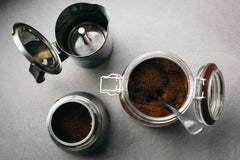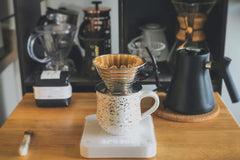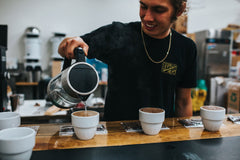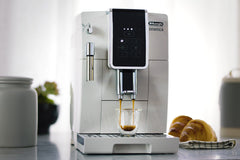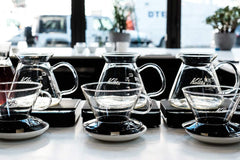If you brew your own coffee at home, chances are, you own a coffee scale.
These will form an important part of your coffee making repertoire and it’s important that you maintain them correctly to get the best use of them.
Sure, some aged coffee connoisseurs will be able to eyeball their measurements and nail them every time, but for the majority of us, scales provide us with a simple, straightforward and accurate way to measure our beans and grounds; this will then lead to a perfect brew ratio and a delicious cup of coffee every time.
However, with equipment comes maintenance and a key element to maintaining functioning scales is to calibrate them regularly. When it comes down to it, coffee scale calibration will fall into your routine of basic equipment maintenance, alongside other routine tasks like cleaning a grinder, deep cleaning a Moka pot, changing filters in an espresso machine and more.
Here’s some more information that will help you to understand scale calibration, as well as getting the process right first time round.
What Is Coffee Scale Calibration?
So, what actually is scale calibration?
Put simply, it is a process that involves checking the reading of a scale by using a reference weight for comparison.
You may find that your scale has a reading error, which is ultimately the difference between the weight the scale shows and the weight that is actually sitting on top of it.
It is recommended that you use certified calibration weights, which will have a specific weight that you can rely on to used as a point of reference for your scales.
When you calibrate your set of scales, it will learn the weight of the calibration weight placed on top of it, using this as a reference point for future measurements.
Why Is It Important to Calibrate Your Scales?
The ultimate goal of calibration is to ensure that your coffee scale is providing the most accurate readings and measurements as possible, helping you to be certain about the exact amount of beans or grounds you are using in your beverages.
When you're on your journey to finding your ideal coffee recipe, you don’t want to risk leaving your measurements to an uncalibrated scale.
Instead, you can carry out some experimentation using different weights of beans or grounds to find the right brew ratio (the ratio of coffee to water) to meet your individual preferences.
Having well calibrated scales can make sure that you are using the correct amount of beans every time.
>> Read our full review of the best coffee scales
Types of Calibration
Of course, there are different types of calibration that you can carry out. A “quick” or “smart” calibration follows the guide outlined above.
If you’re looking for an even more thorough means of calibration, you may want to try a “linear calibration”, which uses weights on different parts of the scales to make sure that they are calibrated in the lower, middle, and upper ranges of its weighing capacity.
How to Calibrate Your Scales
Different scales have different features and modes, so chances are, you’ll need to refer to your users manual to find the specific steps for calibrating your scale.
But here is a general breakdown of the steps required to calibrate your coffee scale:
Step 1: You should make sure that your scale is placed on a flat, even surface and that you have some certified calibration weights.
Step 2: Turn your scale on to its calibration mode and gently place the calibration weight on top.
Step 3: If your scale displays the correct weight, great! If not, you will need to adjust the reading on your scales according to the instructions in your manual.
Bear in mind that your model of scales may require a specific calibration weight, so make sure to read the manual thoroughly before buying your weights.
Below are some video tutorials for a handful of popular coffee scales.
How to Calibrate the Acaia Pearl Scale
How to Calibrate the The Timemore BLACK MIRROR
How to Calibrate the Hario Digital Scale
How to Keep Your Scales Calibrated for Longer
While we would ideally have the time to calibrate our scales between each and every use, few of us have the time to do this in practice. So, you may be wondering how to keep your scales calibrated for longer.
Here are a couple of suggestions that can help.
1. Use a Heat Mat
If you are using your scales for pour over coffee and place your coffee pot directly on the scale, you may want to consider using a heat mat.
It’s good to be aware that high temperatures can have a negative impact on reading accuracy and can damage your scales over time. The same goes for scales that are sensitive to temperature.
Using a heat mat can help to make readings more accurate, as well as extending the life of your scales.
2. Store Your Scales On Their Side
Most of us will automatically store our scales flat out of habit. We’re used to placing them on flat surfaces and using them on flat surfaces, so tend to store them flat too.
But if possible, you should store your scales on their side when they’re not in use.
This can help keep them stay calibrated for longer by reducing pressure on their load cell.
Of course, make sure that they’re not at risk of falling over when stored, as this can damage them. Even better, make sure that they are supported on either side if possible.
How Often Should You Calibrate Your Scales?
In science and experiments, balances and scales tend to be calibrated between each and every use. But for home coffee brewing, you don’t necessarily have to take the time to calibrate your scales so regularly.
At the end of the day, the more often you calibrate your scales, the more accurate their readings will be, so it’s entirely up to you how often you carry this activity out.
High end scales tend to need to be calibrated more often, as their weighing sensors tend to be sensitive to more elements than weight alone. Instead, they can be impacted by temperature, gravity, pressure, voltage and more.
Ideally, you should calibrate once a week if you’re a regular coffee drinker.
Bottom Line on Calibrating your Kitchen Scale
Proper scale calibration plays an important role in your brewing process, so it’s important that you carry it out regularly and accurately.
Follow the steps above and you should experience success!


